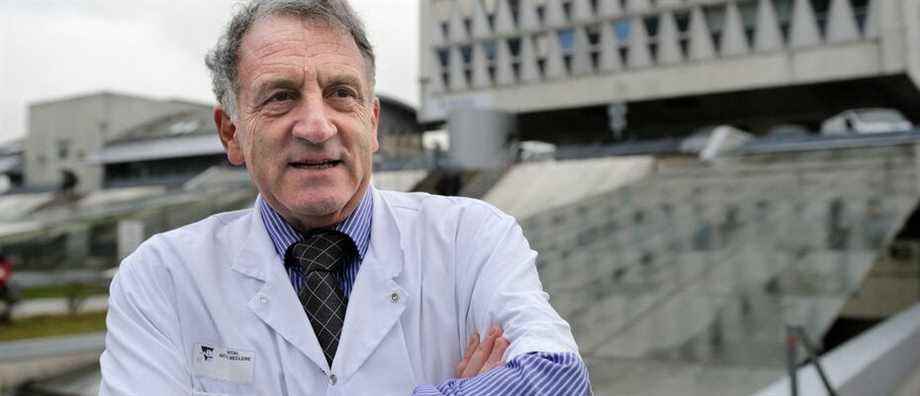40 years ago, to the day, Amadine, the first “test tube baby” was born at the Antoine-Béclère hospital in Clamart by Professor René Frydman, gynecologist and obstetrician.
Amandine was born on February 24, 1986. She was conceived by in vitro fertilization at the Béclère hospital. Professor René Frydman was part of the team, led by Professor Émile Papiernik.
Amandine was born 40 years ago. What memories do you have of that day?
For you, it’s news that fell like that, without preparation. For us, we had been working with Professor Papiernik and Jacques Testart on the development of this technique for several years.
We were prepared but it was an event. The one of the birth of this child that we saw the size of a millimeter. It was obviously an emotion. All births are emotionally charged. But this one was particularly intense.
Amandine was born in the middle of the night and when I got home I felt like I was flying above the road, I was in the air! A child who had just been born naturally, a pretty little girl with present, happy, relaxed parents.
It’s still a transgression from what the world had known
The next day, at a press conference, we announced his birth. I have to say it was exceptional. It was an event, because it is all the same a transgression compared to what the world had known. A child, an embryo was conceived outside the woman’s body. This embryo, until then invisible and untouchable, has become visible and manipulable.
In what way, at that time, was this scientifically exceptional?
It was a first in France but not worldwide. We must render to Caesar what is Caesar’s. The English teams had started in vitro fertilization in animals in 1961. The technique took 17 years to lead to humans. In France, there were capacities but the biological manager at INRA did not want to switch to humans. The English team was ahead worldwide.
How did you work?
We had no equipment. It was DIY. There were no advanced microscopes, incubators… We were on the job and had a lot of questions.
We had no equipment. It was DIY
At the time, the woman had no hormonal treatment. We went fishing, we moved forward at random, according to the natural cycles of women. Today is different, there are treatments. There are several embryos. Freezing was developed from 1986, male treatments exist.
What were the societal consequences? Was it controversial?
Yes, there have been controversies and above all oppositions. On the part of the Catholic Church in particular, which is still opposed to in vitro fertilization. Yet famous scientists considered that we had not taken the necessary paths before moving on to humans and who would have liked us to still work with animals, such as monkeys. For the monkey, it took 20 more years to get there because it’s more complicated than in humans.
Do you have ethical doubts?
It had to be done because in front of us, we had a man and a woman who could not have children. Final point.
It was in the continuity of certain surgical operations such as operating the fallopian tubes (uterine tubes) for example. Why did I switch to in vitro fertilization? I worked in microsurgery, I spent hours and hours fixing these tubes. We repaired them but it didn’t work. When I read in the English newspaper The Lancet that a failed first attempt had been made, my eyes widened and I thought to myself, ‘this is the right thing to do for patients who want a child but who can’t!’
Today, there is the PMA*, the GPA**, do you have the impression of having opened a Pandora’s box?
We must see that society has evolved, the forms of conjugality too. This was not the case 40 years ago.
Society has evolved, forms of conjugality too
I do not feel responsible for the evolution of society, which uses or does not use such and such scientific advances.
The President of the Republic, François Mitterrand, created the National Ethics Committee because in fact we did not see the problems that this could pose: what is an embryo? What is a human being? What is freezing? What does it mean to be able to raise a cell and know the status of a being that is not there yet but of which we already know such and such characteristics?
Not everything is ethically licit
This always poses a certain number of ethical problems, hence the need to have, in my view, certain limits. Not everything is necessarily desirable. Not everything is necessarily ethically licit. It’s a global problem and it’s one of the big issues, along with the death penalty, that we need to think about.
Today, I think we need to develop prevention because there is a lot of couple infertility: endometriosis, pollutants, smoking… And a lot of miscarriages. It is necessary to inform very early without forgetting to evoke “the biological clock”, the age of the woman in particular.
What are your own limits?
Do not confuse what is possible with what is desirable. The possible is unlimited but the desirable is something else… My limits: everything concerning the use of a person for his own benefit, in particular surrogacy. Everything that results in modifying the child according to his own desire, I am thinking of genetic manipulations to draw the profile of a child.
I am not in favor of surrogacy, in particular out of respect for women who have other things to do than bear a child and part with it. We have to be careful with commercialization and commodification. We are touching on fundamental things: what is, a human being. A framework is necessary. Not everything is possible without reflection.
How is Amanda?
Good ! I am in contact with Amandine, her children, her parents. She has become like a member of my family.
*PMA: medically assisted procreation
**GPA: surrogacy
